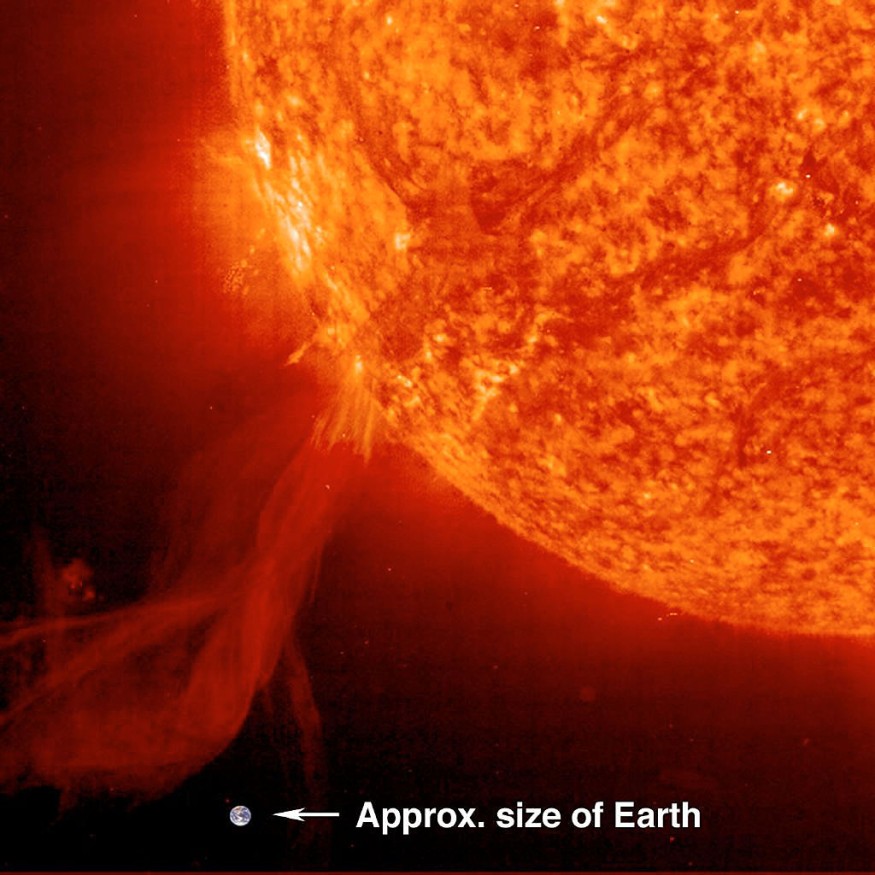As storms wreak havoc throughout Europe and North America this week, the Sun has been undergoing a period of high activity, with repercussions that may be seen on Earth.
Geomagnetic storms are ranked on a scale of 1 to 5, with one being the weakest and five being the most dangerous. Even a G1 geomagnetic storm might cause problems: modest power grid fluctuations and slight disruptions to satellite operations are possible.

Aurora, often known as the "Northern Lights," may be observed from northern Michigan and Maine to points north at high latitudes. As the geomagnetic storm scale grows larger, the effects and aurora vary, according to a report in Weatherboy.
At 6:32 p.m. ET on January 29, an M-class solar flare erupted from Region 2936 on the Sun, according to the SWPC. "As shown in NASA/SOHO LASCO coronagraph images, this flare was linked with an asymmetric, full halo coronal mass ejection (CME)," the SWPC noted.
"Multiple SWPC forecasters' calculations showed a CME speed of around 662 km/s and an at-Earth arrival timeframe as early as late February 1 to early February 2 ET. The forecast confidence in an Earth component to this CME is fair, but the strength and arrival timing have lower degrees of confidence."
Related Article : Expert Warns 'Situation Worse than Covid' if Government Ignores Solar Flare Defense
Spotting CMEs

Before it reaches Earth, CMEs are usually spotted by the NOAA DSCOVR satellite, around 1,000,000 miles distant. Because any geomagnetic storm conditions are anticipated to remain at diminishing levels over the next few days, the SWPC has issued a G1 Geomagnetic Storm Watch for Thursday.
According to the Space Weather Prediction Center, the impact zone will be primarily poleward of 55 degrees Geomagnetic Latitude.
While there are concerns that a future solar storm would knockdown power, phone, and internet connections for weeks, this event does not appear to have that potential. However, some effects are foreseen, such as an energized Northern Lights display at northern latitudes.
The February 2 event is expected to produce aurora as far south as New York, Wisconsin, and Washington State. The K-index, and hence the Planetary K-index, quantify the size of geomagnetic storms.
Kp is a good indication of disturbances in the Earth's magnetic field, according to the SWPCS, and is utilized by SWPC to determine if geomagnetic alerts and warnings are needed for users who are affected by these disturbances. The Kp index can assist in predicting how low the aurora will be, in addition to indicating how profound a geomagnetic storm's impact will be. The storm on February 2 is expected to have a Kp rating of at least 6.
Space weather is mostly caused by the Sun. The Sun can be conceived of as being "stormy" at times, with its surface being more active than usual. When this occurs, the Sun can emit streams of energetic particles in all directions. The aurora borealis (Northern Lights) and aurora australis (Southern Lights) can happen when these charged particles contact the outer regions of our atmosphere.
Coronal Holes
Coronal holes, or dark spots on the Sun, are now one of the principal generators of space weather. According to the Space Weather Prediction Center, coronal holes appear as black spots on the Sun because they are colder than the surrounding plasma and have open magnetic field lines.
These black patches emerge in the Sun's corona, which is the outermost component of its atmosphere. During the recent solar eclipse, the solar corona was also one of the critical characteristics of the Sun that scientists were most interested in studying. These characteristics can be seen in solar photographs in the extreme ultraviolet (EUV) and soft x-ray ranges.
Solar wind constantly flows from the Sun to Earth, although coronal holes release more powerful solar wind. Coronal holes can form anywhere on the Sun, although they are more prevalent around solar minimum. The Sun rotates once every 27 days, and coronal holes can endure for many days.
Permanent coronal holes are prevalent in the Sun's north and south poles, although they can sometimes grow towards the equator, resulting in a bigger area. Coronal holes near the Sun's equator usually result in quicker solar wind reaching Earth. Coronal holes frequently cause G1-G2 geomagnetic storming intensities, and in rare instances, even G3 levels have been observed.
Potential Threats

The incident seriously destroyed the minimal electrical and communication connections available at the time; telegraph systems worldwide failed, with some telegraph operators suffering electric shocks.
According to a June 2013 analysis by Lloyd's of London and Atmospheric and Environmental Research (AER) in the United States, losses in the United States may surpass $2.6 trillion, or nearly 15% of the country's yearly GDP, if the Carrington event occurred today.
The National Oceanic and Atmospheric Administration (NOAA) and its National Weather Service (NWS) are responsible for "space weather." While private companies and other agencies monitor and forecast space weather, the Space Weather Prediction Center is the official source for space weather alerts and warnings (SWPC). The SWPC is a service center of the NWS, which is part of NOAA and is based in Boulder, Colorado.
The Space Weather Prediction Center is one of nine National Centers for Environmental Prediction (NCEP) that track current space weather events around the clock, 365 days a year.
Read also: [UPDATE] Solar Storms: Are They Dangerous?
For more cosmic news, don't forget to follow Nature World News!
© 2025 NatureWorldNews.com All rights reserved. Do not reproduce without permission.





